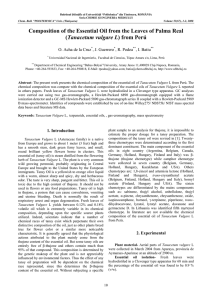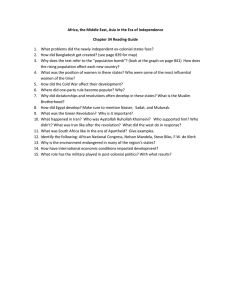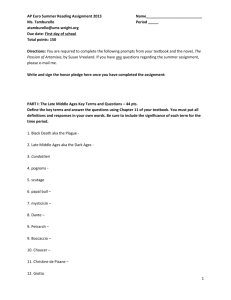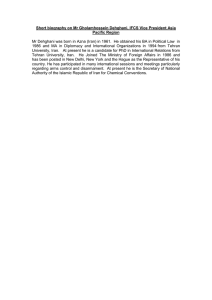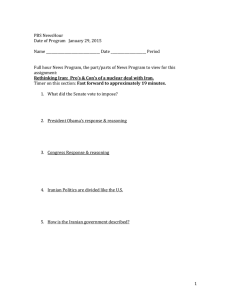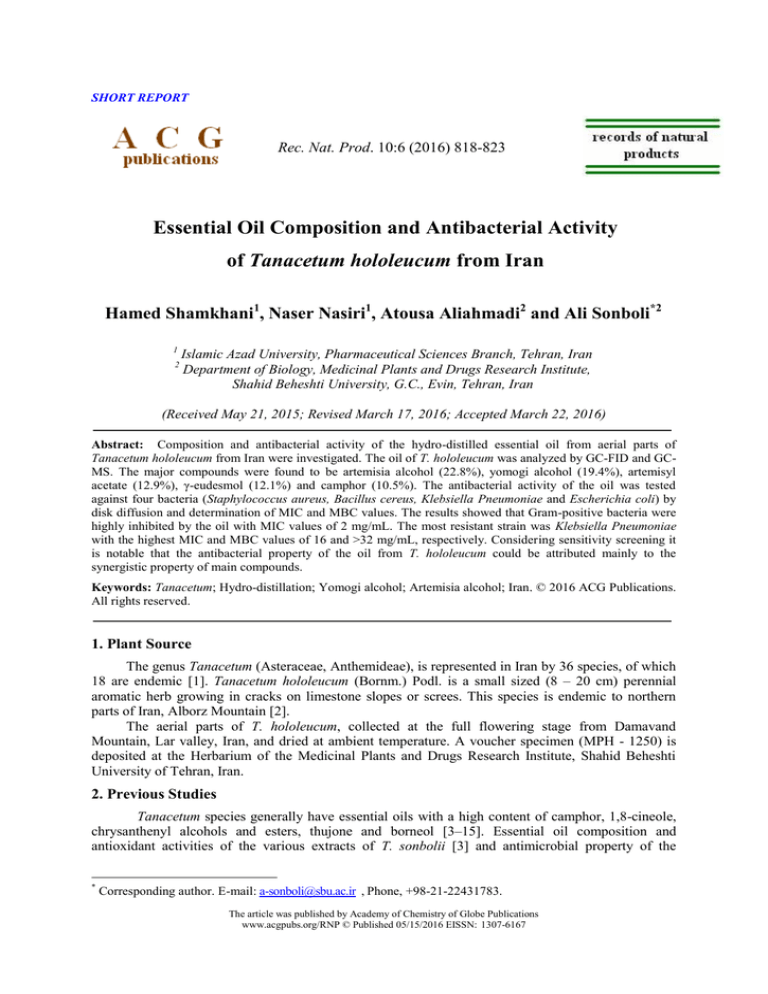
SHORT REPORT
Rec. Nat. Prod. 10:6 (2016) 818-823
Essential Oil Composition and Antibacterial Activity
of Tanacetum hololeucum from Iran
Hamed Shamkhani1, Naser Nasiri1, Atousa Aliahmadi2 and Ali Sonboli*2
1
2
Islamic Azad University, Pharmaceutical Sciences Branch, Tehran, Iran
Department of Biology, Medicinal Plants and Drugs Research Institute,
Shahid Beheshti University, G.C., Evin, Tehran, Iran
(Received May 21, 2015; Revised March 17, 2016; Accepted March 22, 2016)
Abstract: Composition and antibacterial activity of the hydro-distilled essential oil from aerial parts of
Tanacetum hololeucum from Iran were investigated. The oil of T. hololeucum was analyzed by GC-FID and GCMS. The major compounds were found to be artemisia alcohol (22.8%), yomogi alcohol (19.4%), artemisyl
acetate (12.9%), γ-eudesmol (12.1%) and camphor (10.5%). The antibacterial activity of the oil was tested
against four bacteria (Staphylococcus aureus, Bacillus cereus, Klebsiella Pneumoniae and Escherichia coli) by
disk diffusion and determination of MIC and MBC values. The results showed that Gram-positive bacteria were
highly inhibited by the oil with MIC values of 2 mg/mL. The most resistant strain was Klebsiella Pneumoniae
with the highest MIC and MBC values of 16 and >32 mg/mL, respectively. Considering sensitivity screening it
is notable that the antibacterial property of the oil from T. hololeucum could be attributed mainly to the
synergistic property of main compounds.
Keywords: Tanacetum; Hydro-distillation; Yomogi alcohol; Artemisia alcohol; Iran.. © 2016 ACG Publications.
All rights reserved.
1. Plant Source
The genus Tanacetum (Asteraceae, Anthemideae), is represented in Iran by 36 species, of which
18 are endemic [1]. Tanacetum hololeucum (Bornm.) Podl. is a small sized (8 – 20 cm) perennial
aromatic herb growing in cracks on limestone slopes or screes. This species is endemic to northern
parts of Iran, Alborz Mountain [2].
The aerial parts of T. hololeucum, collected at the full flowering stage from Damavand
Mountain, Lar valley, Iran, and dried at ambient temperature. A voucher specimen (MPH - 1250) is
deposited at the Herbarium of the Medicinal Plants and Drugs Research Institute, Shahid Beheshti
University of Tehran, Iran.
2. Previous Studies
Tanacetum species generally have essential oils with a high content of camphor, 1,8-cineole,
chrysanthenyl alcohols and esters, thujone and borneol [3–15]. Essential oil composition and
antioxidant activities of the various extracts of T. sonbolii [3] and antimicrobial property of the
*
Corresponding author. E-mail: a-sonboli@sbu.ac.ir , Phone, +98-21-22431783.
The article was published by Academy of Chemistry of Globe Publications
www.acgpubs.org/RNP © Published 05/15/2016 EISSN: 1307-6167
819
Shamkhani et al., Rec. Nat. Prod. (2016) 10:6 818-823
essential oil of T. fisherae both from Iran [5] have been investigated. Essential oil composition and
antimicrobial activities of T. chiliophyllum var. monocephalum [12] and two chemotypes of T.
chiliophyllum var. chiliophyllum both from Turkey have been studied [13]. The essential oil of
endemic Tanacetum mucroniferum from Turkey showed low DPPH scavenging activity [14].
3. Present Study
The powdered aerial flowering plant parts (50 g) were hydrodistilled using a Clevenger type
apparatus for 3 h. The resulting essential oil was dried over anhydrous sodium sulfate and stored at
4oC until analyzed and tested.
Essential oil analysis: GC-FID analyses of the oil were conducted using a ThermoquestFinnigan instrument equipped with a DB-5 fused silica column (60 m × 0.25 mm i.d., film thickness
0.25 µm). Nitrogen was used as the carrier gas at a constant flow of 1.1 mL/min. The split ratio was
1/50. The oven temperature was raised from 60 ºC to 250 ºC at a rate of 5 ºC/min. The injector and
detector (FID) temperatures were kept at 250 ºC and 280 ºC, respectively. GC-MS analysis was
carried out on a Thermoquest-Finnigan Trace GC-MS instrument equipped with the same column and
using the same temperature programming as mentioned for GC. Transfer line temperature was 250 ºC.
Helium was used as the carrier gas at a flow rate of 1.1 mL/min, with a split ratio equal to 1/50. The
constituents of the essential oils were identified by calculation of their retention indices under
temperature-programmed conditions for n-alkanes (C6 – C24) and the oil on a DB-5 column under the
same conditions. Identification of individual compounds was made by comparison of their mass
spectra with those of the internal reference mass spectral library (Wiley 7.0) or with authentic
compounds.
Antibacterial assay: In vitro antibacterial activity of the essential oil was assessed against two
Gram-positive: Staphylococcus aureus (ATCC 25923) and Bacillus cereus (PTCC 1015) as well two
Gram-negative bacteria; Klebsiella Pneumoniae (Clinical isolate) and Escherichia coli (ATCC
25922). Disk diffusion method was carried out using kirby-bauer method and according to the CLSI
(Clinical Laboratory and Standards Institute) guideline [16]. Broth micro-dilution susceptibility
method using 96 well trays was performed to determine the minimum concentration of essential oil
required for inhibition of visible growth (MIC) or killing (MBC) of the test strains.
For this purpose standard protocol of CLSI (Clinical Laboratory and Standards Institute) was
used with some modifications [16]. The inoculants of the bacterial strains were prepared from freshly
cultured strains, by using sterile normal saline which were adjusted to 0.5 McFarland standard
turbidity and then were further diluted (1:1000 for bacteria) by sterile Mueller-Hinton broth (MHB)
just before adding to the wells containing a desired range of diluted essential oil. Essential oil was
assessed in a concentration range from 64 to 0.06 mg/mL in wells containing MHB medium
supplemented by 0.5% Tween-80 [17]. Inoculated trays were incubated for 20 h at 37°C and then the
MICs were recorded as the lowest concentrations that could inhibit the visible growth of
microorganisms. Minimum bactericidal concentration (MBC) was determined by sub-culturing of 100
µl medium from each negative well and from the positive growth control onto Nutrient agar plates.
MBCs were defined as the lowest concentration that could kill 99.9% of the assessed microorganisms.
Cefixime was used as standard antibiotic. All tests were performed in triplicate.
The hydrodistillation of aerial parts of T. hololeucum gave yellow oil in 0.3 % (w/w) yield,
based on the dry weight of the plant. Thirty-five components were identified representing 99.9 % of
the total oil. The qualitative and quantitative essential oil compositions are presented in Table 1, where
compounds are listed in order of their elution on the DB – 5 column. GC-MS chromatogram of the
essential oil of T. hololeucum is presented as supporting file (S1). The major constituents of the oil
were found to be artemisia alcohol (22.8%), yomogi alcohol (19.4%), artemisyl acetate (12.9%), γeudesmol (12.1%) and camphor (10.5%) followed by β-pinene (3.6%), α-pinene (2.5%), neryl acetate
(2.3%), cis-thujone (2.2%) and 1,8-cineole (2.1%). The classification of the identified constituents
based on functional groups is summarized at the end of Table 1. The oxygenated monoterpenes as the
principal compound group constituting 75.9% followed by oxygenated sesquiterpenes comprising
14.6% of the total oil. Monoterpene and sesquiterpene hydrocarbons represented 8.8 and 0.6 % of the
oil, respectively.
820
Essential oil of Tanacetum hololeucum from Iran
Table 1. Percentage composition of the essential oil of Tanacetum hololeucum
No.
Component
RIa
LRIb
%
1
2
3
4
5
6
7
8
9
10
11
12
13
14
15
16
17
18
19
20
21
22
23
24
25
26
27
28
29
30
31
32
33
34
35
santolina triene
artemisia triene
α-pinene
camphene
sabinene
β-pinene
yomogi alcohol
p-cymene
limonene
1,8-cineole
artemisia ketone
γ-terpinene
cis-sabinene hydrate
artemisia alcohol
cis-thujone
trnas-thujone
camphor
artemisyl acetate
terpinen-4-ol
α-terpineol
myrtenal
trans-chrysanthenyl acetate
bornyl acetate
neryl acetate
α-copaene
(E)-caryophyllene
β-selinene
germacrene D
lavandulyl isovalerate
elemol
spathulenol
caryophyllene oxide
γ-eudesmol
β-eudesmol
valeranone
907
925
941
958
979
986
998
1029
1035
1039
1060
1063
1073
1087
1113
1123
1156
1169
1186
1196
1204
1244
1293
1361
1391
1440
1492
1500
1508
1564
1598
1608
1656
1677
1701
906
923
932
946
969
974
999
1020
1024
1026
1056
1062
1065
1080
1101
1112
1141
1169
1174
1186
1195
1235
1284
1359
1374
1417
1489
1499
1509
1548
1577
1582
1630
1649
1674
1.1
0.2
2.5
0.8
0.1
3.6
19.4
0.3
0.1
2.1
0.4
0.1
0.2
22.8
2.2
0.6
10.5
12.9
0.4
0.1
0.2
1.6
0.2
2.3
0.1
0.2
0.2
0.1
0.3
0.1
0.3
0.5
12.1
0.6
0.7
Monoterpen hydrocarbons
Oxygenated monoterpens
Sesquiterpene hydrocarbons
Oxygenated Sesquiterpens
Total
a
b
8.8
75.9
0.6
14.6
99.9
RI, retention indices relative to C6–C24 n-alkanes on the DB-5 column;
LRI, retention indices published in literature.
Once, Hayashi et al. [18] isolated and elucidated the structure of yomogi alcohol A, a
monoterpene alcohol from Artemisia feddei Lev. et Van. Subsequently, this compound has been
identified and reported in several species of genera Artemisia and Achillea. Yomogi alcohol (38.47%),
artemisyl acetate (24.88%), and artemisia alcohol (6.70%) have already characterized as the dominant
compounds in the essential oil of Artemisia abyssinica from Ethiopia [19]. In the essential oil obtained
from Artemisia lavandulaefolia DC. from South Korea yomogi alcohol (4.5%) was found as one of the
main compounds [20]. The major components of the leaf oil of A. douglasiana [21] have been found
to be camphor (29%), artemisia ketone (26%) and artemisia alcohol (13%). As far as our literature
survey could ascertain, these irregular monoterpenoids have not been reported in the essential oils of
Tanacetum species.
821
Shamkhani et al., Rec. Nat. Prod. (2016) 10:6 818-823
Camphor, 1,8-cineole and borneol has almost been reported as the third major compounds in
the essential oils of different Tanacetum species. A summary of the previous published data on the
three main compounds of essential oils in Tanacetum species has been presented in Table 2. Regarding
major compounds of T. hololeucum and previous reports on the oil compounds of other Tanacetum
species (Table 2), it could be concluded that there is notable differences in the main marker
constituents of the essential oils within Tanacetum species.
Table 2. A summary of the published data on the main compounds of Tanacetum essential oils
Species
T. chiliophyllum var. monocephalum
T. polycephalum subsp. argyrophyllum
T. polycephalum subsp. polycephalum
T. polycephalum subsp. duderanum
T. densum
T. densum subsp. amani
T. cadmeum
T. alyssifolium
T. parthenium
T. aucheranum
T. gracile
T. tabrisianum
Plant part
used
FL
AP
AP
AP
FL
ST
AP
ST
FL
ST
AP
FL& ST
AP
AP
FL
ST
Camphor
17.3%
52.0%
37.3%
8.0%
19.2%
16.4%
15.6%
10.4%
25.9%
14.8%
12.4%
18.94%
11.6%
1.4%
0.8%
1,8-Cineole
8.3%
36.3%
8.8%
21.1%
28.3%
11.5%
2.5%
6.6%
7.4%
4.8%
23.8%
15.2%
17.6%
22.5%
Borneol
9.4%
8.3%
5.8%
6.4%
7.5%
15.4%
25.8%
35.2%
10.93%
3.8%
6.1%
6.9%
3.3%
Ref.
12
6
6
6
15
15
10
10
8
8
7
23
25
29
11
11
AP, Arial Part; FL, Flower; ST, Stem
As shown in the table 3, assessed essential oil has revealed a moderate antibacterial activity.
S. aureus has been the most sensitive bacterium together with B. cereus strain. However IZ of
S. aureus has been greater than that of B. cereus. Both Gram-positive bacteria were inhibited by the
essential oil with MIC values of 2 mg/mL whereas MIC values for E. coli and K. pneumoniae were 16
mg/mL. The lowest concentration which could result in fully inhibition by killing of microorganisms
was that of B. cereus (MBC: 2 mg/mL). Tested K. pneumoniae strain was the most resistant bacterium
with MIC value greater than 32 mg/mL.
Plants are known as hopeful and valuable natural resource of antimicrobial agents [22].
Antibacterial activities of the essential oils of different Tanacetum species have been reported
previously [9,10, 12, 23] and biological activities of members of this genus have been reviewed by
Kumar & Tyagi [24]. A moderate inhibitory activity for essential oils extracted from Tanacetum
aucheranum and Tanacetum chiliophyllum var. chiliophyllum against 30 phytopathogenic fungi as
well as 33 plant and human pathogenic bacteria has been reported by Salamci et al. [25]. They showed
a broad spectrum of activities against both Gram positive and Gram negative bacteria. However in
other study [10], assessed Gram positive bacteria such as B. cereus showed more sensitivity against
essential oil of Tanacetum aucheranum and Tanacetum chiliophyllum var. chiliophyllum which is in
accordance with the result of our study on Tanacetum hololeucum. Some constituents of assessed
essential oil, such as camphor [26], β-pinene and α-pinene [27], and 1,8-cineole [26, 28] have a
confirmed antibacterial properties. However the antibacterial property of T. hololeucum oil could be
attributed mainly to the synergistic property of its main components.
822
Essential oil of Tanacetum hololeucum from Iran
Table 3. Antibacterial activity of the essential oil of Tanacetum hololeucum
Microorganisms
Staphylococcus aureus (ATCC 25923)
Bacillus cereus (PTCC 1015)
Escherichia coli (ATCC 25922)
Klebsiella pneumoniae (Clinical isolate)
1
IZ1
35
14
12
9
Essential oil
MIC2
MBC2
2
32
2
4
16
16
16
>32
Cefexime
MIC3
MBC3
1
4
0.5
1
8
16
32
64
Inhibition zone diameter (mm); 2 Values given as mg/mL; 3 Values given as µg/mL.
References
[1]
[2]
[3]
[4]
[5]
[6]
[7]
[8]
[9]
[10]
[11]
[12]
[13]
[14]
[15]
[16]
M. Kazemi, A. Sonboli, H. Zare-Maivan and S. Kazempour Osaloo (2014). A taxonomic reassessment
of the Tanacetum aureum (Asteraceae, Anthemideae) species group: insights from morphological and
molecular data, Turk. J. Bot. 38, 1259-1273.
V. Mozaffarian (2008). Compositae: Anthemideae and Echinopeae in Flora of Iran, Eds. M. Assadi, A.
A. Maasoumi, M. Mozaffarian, Research Institute of Forests and Rangelands Press, Tehran, 59, 134198.
M. Firozy, Z. Talebpour and A. Sonboli (2012). Essential oil composition and antioxidant activities of
the various extracts of Tanacetum sonbolii Mozaff. (Asteraceae) from Iran, Nat. Prod. Res.26, 2204 –
2207.
K. Javidnia, M. Gholami, O. Firuzi, H. Özer and A. Kandemir (2010). Antimicrobial and antioxidant
activity and chemical composition of the essential oil of Tanacetum macrophyllum (Waldst. et Kit.) Sch.
Bip., J. Essent. Oil Res. 22, 186-188.
P. Rajaei, T. Nejadsattari, A.A. Maassoumi, V. Mozaffarian and A. Sonboli (2011). Micromorphology of
glandular hairs, biological activity and composition of the essential oil of Tanacetum fisherae
(Asteraceae-Anthemideae) from Iran, Nat. Prod. Commun. 6, 259-262.
F. Sefidkon, G. Najafi, V. Mozaffarian and H. Zare-Maivan (2007). Essential oil variability of eight
populations of Tanacetum polycephalum from Iran, Nat. Prod., An Ind. J. 3, 920-926.
A. Kandemir, H. Özer, H. Kilic, A. Cakir and Y. Demir (2008). Essential oil composition of Tanacetum
alyssifolium, an endemic species from Turkey, Chem. Nat. Compd. 44, 530-531.
K. Polatoĝlu, N. Gören, K.H.C. Başer and B. Demirci (2009). The variation in the essential oil
composition of Tanacetum cadmeum (Boiss.) Heywood ssp. orientale Grierson from Turkey, J. Essent.
Oil Res. 21, 97-100.
K. Polatoĝlu, F. Demirci, B. Demirci, N. Gören and K.H.C. Baser (2010a). Antibacterial activity and the
variation of Tanacetum parthenium (L.) Sch. Bip. essential oils from Turkey, J. Oleo Sci. 59, 177-184.
K. Polatoĝlu, F. Demirci, B. Demirci, N. Gören and K.H.C. Baser (2010b). Essential oil composition
and antibacterial activity of Tanacetum argenteum (Lam.) Willd. ssp. argenteum and T. densum (Lab.)
Sch. Bip. ssp. amani Heywood from Turkey, J. Oleo Sci. 59, 361-367.
K. Polatoĝlu, B. Demirci, N. Gören and K.H.C. Baser (2011). Essential oil composition of endemic
Tanacetum zahlbruckneri (Náb.) and Tanacetum tabrisianum (Boiss.) Sosn. and Takht. from Turkey,
Nat. Prod. Res. 25, 576-584.
K. Polatoĝlu, F. Demirci, B. Demirci, N. Gören and K.H.C. Baser (2012a). Essential oil composition
and antimicrobial activities of Tanacetum chiliophyllum (Fisch. & Mey.) Sch. Bip. var. monocephalum
Grierson from Turkey, Rec. Nat. Prod. 6, 184-188.
K. Polatoĝlu, B. Demirci, F. Demirci, N. Gören and K.H.C. Baser (2012b). Biological activity and
essential oil composition of two new Tanacetum chiliophyllum (Fisch. & Mey.) Sch. Bip. var.
chiliophyllum chemotypes from Turkey, Ind. Crop. Prod. 39, 97-105.
K. Polatoĝlu, A. Sen, A. Kandemir and N. Gören (2012c). Essential oil composition and DPPH
scavenging activity of endemic Tanacetum mucroniferum Hub. Mor. & Grierson from Turkey, J. Essent.
Oil Bearing- Pl. 15, 66-74.
K. Polatoĝlu, B. Demirci, F. Demirci, N. Gören and K.H.C. Baser (2012d). The essential oil
composition of Tanacetum densum (Labill.) Heywood ssp. eginense Heywood from Turkey, Rec. Nat.
Prod. 6, 402-406.
J. H. Jorgensen and J. D. Turnidge (2007). Susceptibility test methods: Dilution and disk diffusion
methods, in: Eds. P. R. Murray, E. J. Baron, J. H. Jorgensen, M. R. Landry, M. A. Pfaller, Manual of
Clinical Microbiology. 9 ed. Washington DC, ASM Press; pp. 1152-1172.
823
[17]
[18]
[19]
[20]
[21]
[22]
[23]
[24]
[25]
[26]
[27]
[28]
[29]
Shamkhani et al., Rec. Nat. Prod. (2016) 10:6 818-823
B. Tepe, M. Sokmen, A. Sokmen, D. Daferera and M. Polissiou (2005). Antimicrobial and antioxidative
activity of the essential oil and various extracts of Cyclotrichium origanifloium (Labill.) Manden &
Scheng., J. Food Eng. 69, 335-342.
S. Hayashi, K. Yano and T. Matsuura (1968). Yomogi alcohol A, a new monoterpene alcohol from
Artemisia feddei Lev. et Van., Tetrahedron Lett. 59, 6241-6243.
Y. Tariku, A. Hymete, A. Hailu and J. Rohloff (2010). Essential oil composition, antileishmanial, and
toxicity study of Artemisia abyssinica and Satureja punctata ssp. punctata from Ethiopia, Chem.
Biodivers. 7, 1009-1018.
J. D. Cha, M. R. Jeong, H. J. Choi, S. I. Jeong, S. E. Moon, S. I. Yun, Y. H. Kim, B. S. Kil and Y. H.
Song (2005). Chemical composition and antimicrobial activity of the essential oil of Artemisia
lavandulaefolia, Planta Med. 71, 575-577.
W. N. Setzer, B. Vogler, J.M. Schmidt, J.G. Leahy and R. Rives (2004). Antimicrobial activity of
Artemisia douglasiana leaf essential oil, Fitoterapia 75, 192-200.
M. M. Cowan (1999). Plant products as antimicrobial agents, Clin. Microbiol. Rev. 12, 564-582.
F. Mohsenzadeh, A. Chehregani and H. Amiri (2011). Chemical composition, antibacterial activity and
cytotoxicity of essential oils of Tanacetum parthenium in different developmental stages, Pharmceutical
Biol. 49, 920-926.
V. Kumar and D. Tyagi (2013). Chemical composition and biological activities of essential oils of genus
Tanacetum - a review, J Pharmacogn Phytochem. 2, 159-163.
E. Salamci, S. Kordali, R. Kotan, A. Cakir and Y. Kaya (2007). Chemical compositions, antimicrobial
and herbicidal effects of essential oils isolated from Turkish Tanacetum aucheranum and Tanacetum
chiliophyllum var. chiliophyllum, Biochem. Syst. Ecol. 35, 569-581.
A. Sökmen, G. Vardar-Ünlü, M. Polissiou, D. Daferera, M. Sökmen and E. Dönmez, (2003).
Antimicrobial activity of essential oil and methanol extracts of Achillea sintenisii Hub. Mor.
(Asteraceae), Phytother Res. 17, 1005-1010.
A. C. Rivas Da Silva, P. M. Lopes, M. M. Barros de Azevedo, D. C. Costa, C. S. Alviano and D. S.
Alviano (2012). Biological activities of α-pinene and β-pinene enantiomers, Molecules 17, 6305-6316.
C. Cermelli, A. Fabio, G. Fabio and P. Quaglio (2008). Effect of Eucalyptus essential oil on respiratory
bacteria and viruses, Curr. Microbiol. 56, 89-92.
M. Verma, S. K. Singh, S. Bhushan, H. C. Pal, S. Kitchlu, M. K. Koul, R. K. Thappa and A. K. Saxena
(2008). Induction of mitochondrial dependet apoptosis by an essential oil from Tanacetum gracile,
Planta Med. 74, 515-520.
© 2016 ACG Publications

